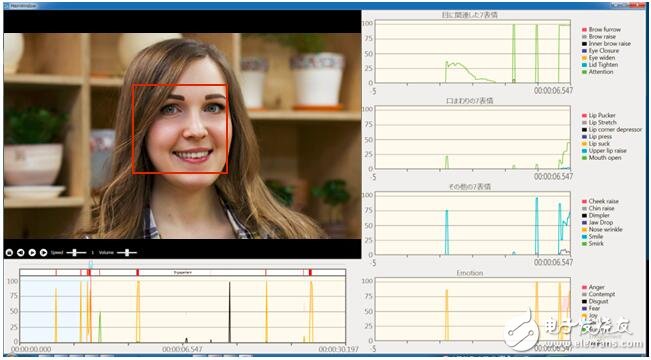"Heart Sensor" can use artificial intelligence to identify people's emotions
According to James Consulting, CAC, a company based in Tokyo, Japan, launched its video analytics product called "Heart Sensor" (Ver.1.0) on February 1, 2018. This innovative tool leverages artificial intelligence (AI) to detect and interpret human emotions through facial expressions, converting them into digital signals for further analysis.
The "Heart Sensor" is designed to analyze the emotional expressions of characters in videos or movies, enabling it to "read" and translate their feelings into actionable data. This makes it an invaluable asset for commercial entities looking to conduct social research, such as customer satisfaction surveys or user feedback analysis during product development stages.

The interface after analyzing character expressions using the "Heart Sensor" provides a clear visual representation of the emotional data extracted from the video content. This helps users understand how viewers might react emotionally to different scenes or characters.
Developed using Affectiva’s EmoTIon Artificial Intelligence platform, the "Heart Sensor" benefits from years of research and development. Affectiva, originally spun off from the MIT Media Lab in 2009, has attracted significant investment from top venture capital firms like Kleiner Perkins Caufield Byers, Horizon Ventures, Fenox Venture Capital, and WPP.

Affectiva's Emotion AI Platform Demo highlights the potential of this technology in real-world applications, from market research to user experience studies.
Key features of the "Heart Sensor" include:
- It analyzes 34 facial landmarks in videos to quantify seven core emotion values, 21 expression values, and two special indices.
- Results can be exported as CSV files for further analysis or integration with other systems.
- The software can run locally without needing an internet connection, ensuring data privacy and security during processing.
To use the "Heart Sensor," CAC offers software tools along with certified USB-based authentication devices under periodic licensing agreements. Users can then process and analyze target videos directly on their personal computers.
The development of "Heart Sensor" was driven by the growing demand for emotion recognition across various industries. As more businesses seek insights from video content, CAC aimed to create a user-friendly solution that simplifies the process of analyzing emotional responses without requiring advanced technical expertise.
For organizations lacking internal AI capabilities, the "Heart Sensor" provides an accessible way to integrate emotion recognition into their workflows. For those seeking more customization, Affectiva also offers its SDK for deeper integration and development.
Looking ahead, CAC plans to enhance the "Heart Sensor" with new features such as real-time video analysis, multi-person sentiment detection, and personnel identification. These updates are expected to be rolled out by the end of February and March 2018, respectively.
Emotion recognition AI technology uses deep learning algorithms to analyze facial expressions and classify human emotions with high accuracy. As more data is collected and processed, the system becomes increasingly reliable, making it a powerful tool for businesses, researchers, and developers alike.
Transmission And Distribution Pole
Steel poles are commonly used to carry several types of electric power lines, distribution lines and lighting system. Distribution lines carry power from local substations to customers. They generally carry voltages from 4.6 to 33kV for distances up to 30 miles, and include transformers to step the voltage down from the primary voltage to the lower secondary voltage used by the customer. A service drop carries this lower voltage to the customer's premises.
Transmission And Distribution Pole,Transmission Line Poles,Power Transmission Line,Galvanized Transmission and Distribution Pole
Yixing Steel Pole International Trading Co., Ltd , https://www.yx-steelpole.com